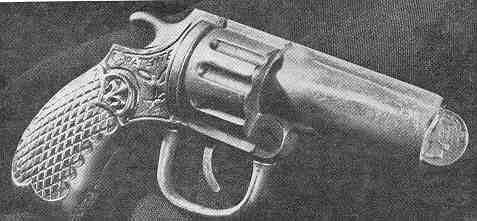Pistol Bank
by F.H. Griffith - HOBBIES Magazine - December, 1961

A toy pistol that could be said to have double barrel interest is our choice as No. 99 in the numerical classification of mechanical banks. The clever dual purpose toy is not only an interesting, unusual action mechanical bank, but it could also be played with as a toy pistol. Thus, it has double interest, not only to collectors of mechanical banks, but also to collectors of toy pistols as well. Another point in its favor is the fact that it is one of the few mechanical banks that represent an object. The limited number of banks that fit into this category were dealt with in the article on the Safety Locomotive Bank (HOBBIES, September, 1960). The Safety Locomotive and the Pistol Bank also have another point in common since both banks require dimes in their operation in order to work properly.
The Pistol Bank was patented by James Hall Bevington of Chicago, Ill., September 21, 1909. He assigned his patent to Edward N. Heller, also of Chicago, doing business under the name of Richard Elliott Company. The patent papers covering the bank are very detailed and lengthy covering over five pages of written description and another sheet with 14 figure drawings. The Pistol as manufactured by the Richard Elliott Company is practically identical to the patent papers with the exception of a bell which was intended to ring when the trigger was pulled. The bell was to have been contained inside the cylinder section of the Pistol, but for some reason, perhaps due to manufacturing difficulties, this was omitted in the actual production of the bank.
It also bears mention that the patent papers always refer to the bank as a toy pistol or coin receiving toy pistol. On occasion some collectors in past years have referred to the bank as the Revolver Bank, however, logically, since the patent papers are so explicit and since it is a toy pistol, it would be best to standardize on the name Pistol Bank.
The bank shown is in fine original condition and was obtained by the writer some years ago from an Ohio antique dealer. It is made of cast iron with a nickel plate finish. The fact it is cast iron is brought out since at a later date during the period of the manufacture of the bank it was also made in a sheet iron stamping with a nickel plate finish. Both types operate the same and so on, however, the one made in cast iron is more desirable.
The operation of the bank is simple, fast and efficient, but quite different and unexpected. Naturally a toy pistol has the effect of firing something out of the barrel, whereas with the Pistol Bank a coin is in effect fired into the barrel. To operate the bank a dime is placed in the end of the barrel as shown in the picture. It stays in place and when the trigger is pulled a lever snaps out from inside the barrel, engages the coin and snaps it back into the barrel and down inside the butt of the pistol. The action is very fast and simultaneous with the pulling of the trigger. Coins are removed by means of a combination key mechanism in the base of the butt. This coin trap part has the following inscribed thereon: "Manufactured By Richard Elliott Company, Chicago, Ill." Also the word "Patented" appears under the hammer on each side of the Pistol.
The Pistol bank with its unique action and dual appeal makes a very interesting desirable addition to a collection of mechanical banks. It is not an easy item to find and most likely many were originally broken or put out of commission due to being played with as a toy, not necessarily as a savings device.
